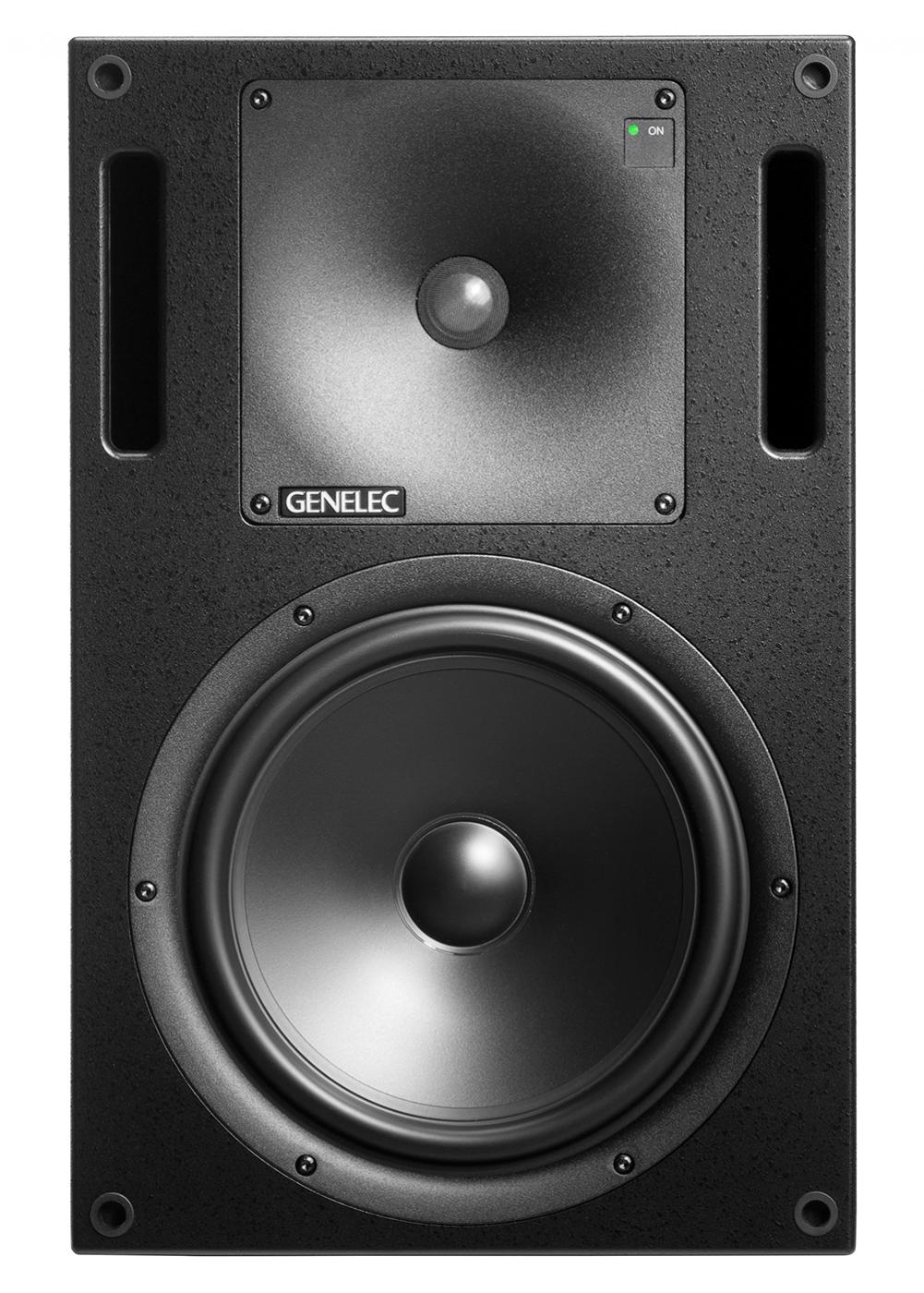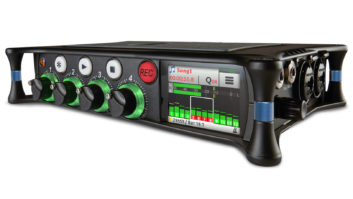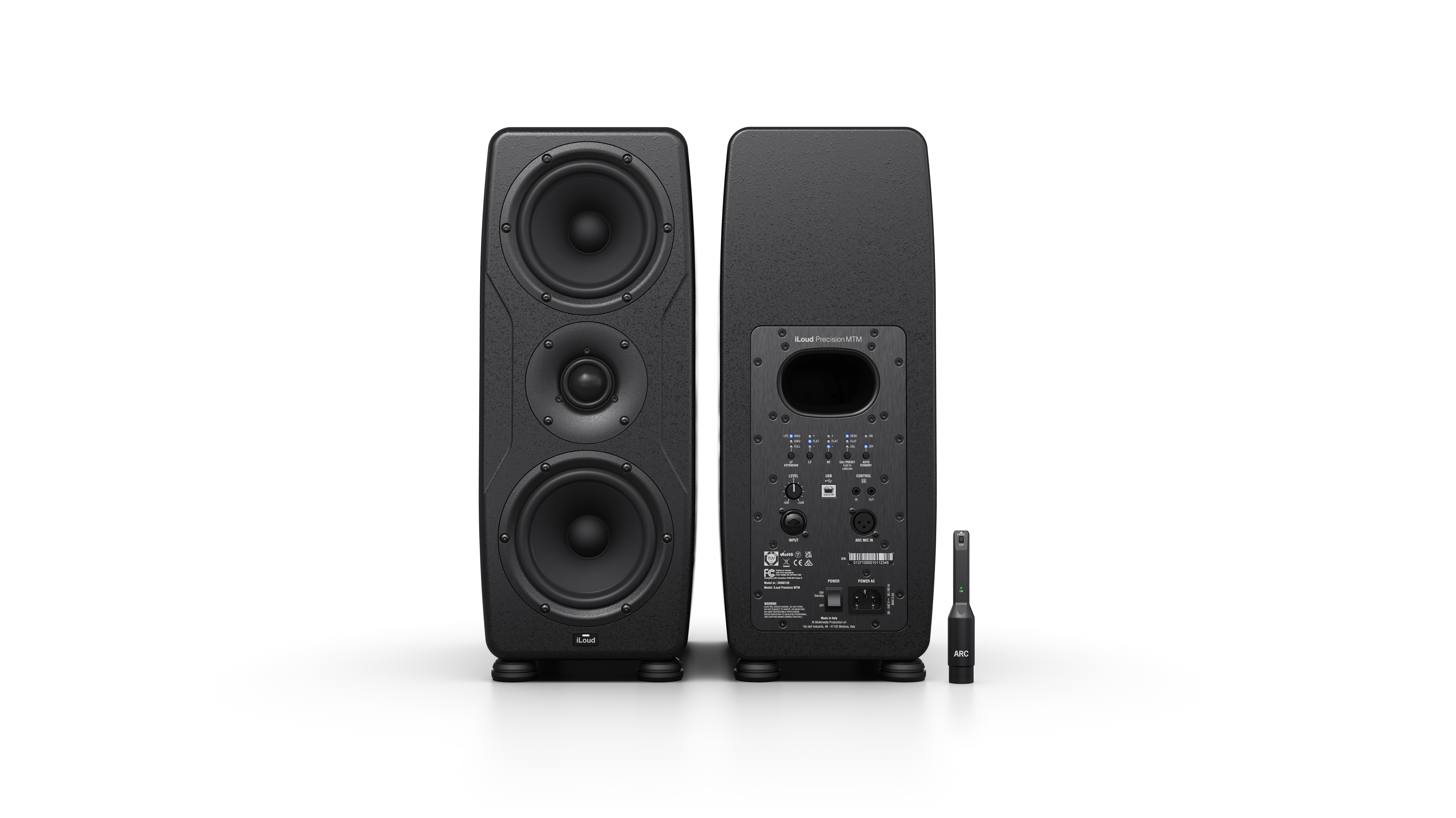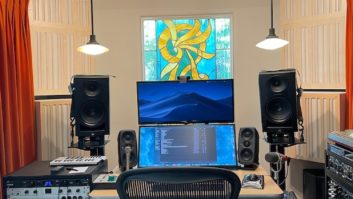The recently released Genelec 1032C is the third generation of Genelec’s legendary 1032 monitor. The 1032A was launched in 1992 and was then replaced by the 1032B in 2013. The 1032C is the latest version of the monitor and besides the addition of Genelec’s Smart Active Monitoring (SAM) technology, it offers several improvements over its predecessor.
The substantial 1032C weighs 37.4 lbs. and measures 19-1/2 inches high by 12-5/8 inches wide by 11-7/16 inches deep. It supports input via line level analog or AES/EBU digital signal (32 – 192 kHz and 16- to 24-bit).
The 1032C incorporates an active digital crossover (with a crossover frequency of 1.8 kHz and 48 dB/octave slopes) that splits the signal feeding the 1-inch metal dome tweeter and 10-inch woofer, both of which are powered by onboard Class D amplifiers, thus reducing the weight of each speaker by more than 5 pounds. Compared to the 1032B’s 120 W and 180 W amplifiers, the 1032C tweeter and woofer power amplifiers are respectively rated at 150 W and 250 W. In regards to internal filtering, the speaker has a constant latency (group delay) down to 300 Hz.
Any fan of the previous 1032 models (I fall into this group!) will absolutely love the 1032C. These monitors offer the same immaculate imaging, impressive off-axis response and broad dynamic range as their predecessors but with an extended low frequency response (the frequency response is 40 Hz – 20 kHz), increased SPL capacity (the maximum SPL is 114 dB) and Genelec Loudspeaker Manager (GLM) compatibility.
The SAM technology incorporates multiple features that allow the monitors to be tailored to a specific work environment via the GLM software or manually via a series of DIP switches located on the rear panel. While the SAM DIP switches are convenient if there isn’t a computer available, Genelec always recommends utilizing GLM to set up a SAM monitoring system.
SAM DIP switch controls include Bass Roll Off (three variations), Desktop low-frequency control (attenuates the bass frequencies around 160 Hz by 4 dB, compensating for the anomalies created by the desktop), Bass Tilt Control (attenuates frequencies below 800 Hz to compensate for anomalies created when the monitors are placed near room boundaries), Treble Tilt Control (boosts or cuts frequencies above 5 kHz, correcting an excessively bright or dull sounding system or compensating for high-frequency loss if the monitor is placed behind a screen), Intelligent Signal Sensing (ISS), Digital (activates the monitor’s AES/EBU digital input), Level (scales the monitor’s output level down in 10 dB steps) and Stored (switches between the monitor’s back panel settings or the settings stored inside the monitor via the GLM system calibration software). When the GLM network is disconnected, the settings stored utilizing the GLM software can be selected for use by setting the Stored SAM DIP switch to the ON position. Setting the switch to the OFF position selects the settings defined by the monitor’s own onboard DIP switch controls. Using the Stored option supersedes all adjustments done with the monitor’s built-in controls.

Although the 1032C can be used without the GLM software and control network, the full potential of the monitors can only be met when they are set up and calibrated with the GLM software, which provides automated acoustic equalization and alignment for any system configuration. GLM setup is quick, easy and accurate. The settings can be controlled with a computer or be permanently stored in the monitors to make the setup available at all times, even when a computer is not in use. Regardless of the speaker model, any number of SAM-equipped monitors can be utilized together to create a recallable network, from stereo to 5.1 to large immersive set-ups.
I couldn’t wait to give the 1032Cs a listen, so before messing with the GLM setup, I confirmed the Store switch was not active and was set to neutral, and then I spent some time listening to the monitors in my mix room. Straight out of the box, they sounded amazing. The imaging was spectacular, the top end was pristine and the bottom end was full and rich, and while possibly slightly lacking in clarity, still impressive. After a couple of hours, I was ready to give GLM a go. I used an earlier version of GLM a few years ago and was immediately surprised at how much easier it is to use now. I have memories of having to reference documentation multiple times to get it up and running, but the current version is simple and straight forward; I had it running in no time. It’s as simple as connecting a Cat 5 cable between each monitor and subwoofer (my system was simply two 1032Cs, no sub) and then to the control network input of the GLM Adapter device. The GLM Adapter device then connects to a computer via USB. I positioned the included mic (pointed upwards) at the listening position with the top of the mic at the approximate height of my ears, and then connected it to the GLM Adapter device. That’s it, as far as the physical setup goes. The GLM software is a quick download from the company’s website, and then running the software performs a series of tests optimizing the monitors to their environment by making adjustments for details such as speaker location and time of flight irregularities to ensure the finest possible monitoring experience within the room. The 1032C also incorporates Video Delay Compensation and level calibration.
I was stunned at the difference the GLM made to the sound of monitors. The clarity I was missing in the bottom end was instantly resolved. The imaging was slightly better, the top end felt more extended and the sweet spot actually felt more accurate. Since the GLM software allows the GLM settings to be bypassed and activated at the push of a button, it is easy to analyze the differences that GLM makes to the listening experience. I’ve used a fully calibrated system multiple times and in each instance, have found that the more problematic the room, the more of a difference GLM makes.
While unlimited presets can be easily saved in the computer, only one GLM configuration can be stored in the monitors. This means if you frequent a number of different studios on a regular basis and carry your monitors with you, you will have to use your computer to recall the configuration for each location. I wish you could store more than a single setting in the speakers.
During my eight-week review period, I’ve found that the 1032Cs translate extremely well. It is easy to tell when a mix is finished or if it needs more work, and when you get it out of your space, you know what it’s going to sound like elsewhere. The SAM system allows the monitors to provide amazingly accurate monitoring in virtually any room, which is ideal for engineers (like most I know) who regularly work in a multitude of different settings. I’ve utilized the monitors in six or seven spaces, and in every instance, have been pleased with their performance.
The monitors are extremely flat and natural sounding, with stunning imaging. They are remarkably transparent and their extremely low distortion keeps them from being fatiguing. Long days don’t result in fried ears as happens with many monitors out there. They are loud, too—really loud, perfectly suited to rock out and give a band the larger than life playback experience. The clarity and precision remain intact even at loud volumes though, which is sadly not typical with most monitors out there.
The 1032C is a perfect option for any music production, postproduction or broadcast studio.
Genelec • www.genelec.com







